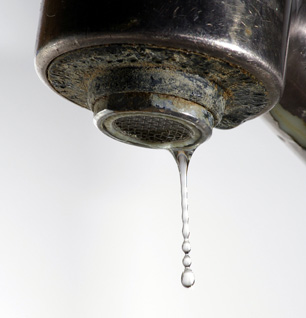Hardness

Hard water has caused calcification on this faucet.
Hardness in water is determined by the mineral content, specifically the amount of calcium and magnesium salts. Salts are formed when calcium and magnesium combine with bicarbonates, sulfates, chlorides, and nitrates.
The standard measurement of hardness in water is “grains per gallon,” with a grain representing 17.1 parts per million. Grains per gallon is usually reported “as calcium carbonate” (CaCO3) to facilitate comparison with other constituents of the water.
There are a variety of definitions of where “hard” water begins, but there is general agreement that water of 7 grains per gallon or more is hard enough that things would be improved by a water softener.
Water Treatment for Hardness
The standard treatment for hardness is a water softener. It can treat up to about 100 grains per gallon of hardness, although it's less effective when a large amount of sodium is present.
Reverse osmosis also removes hardness, but RO membranes are susceptible to scale. Municipalities use a process called “lime softening” which lowers but won't remove hardness completely. Other alternatives to conventional softening include sequestering with polyphosphates and electronic- or media-based treatments that do not remove hardness but condition it to be less objectionable.
Photo Source: WikiMedia, author: Hustvedt
Site Index
Filtration Systems
- Aeration for Iron & Sulfide
- Backwashing Filters
(whole house & well units)
- Chlorine & Chemical Injectors
- Countertop Water Filters
- Garden Hose Filters
- Reverse Osmosis, Residential
- Reverse Osmosis, Commercial
- Shower Filters
- Specialty Filters
- Ultraviolet Systems
- Undersink Filters
- Water Softeners
- Whole House Filters
Cartridges
Parts
- Replacement Parts
- Faucets
- Filter Media
- Fittings
- Housings
- O-rings
- Pumps
- Pura UV
- R.O. Parts
- R.O. Tanks
- R.O. Booster Pump
- VIQUA UV